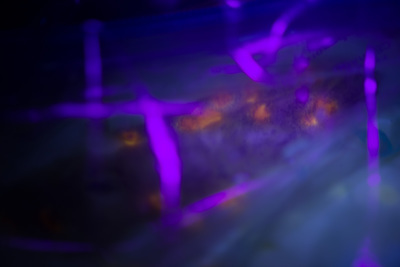A Brief Detour to Digital Land
The past few months I’ve worked mostly with film, and I’ve been reminded why I didn’t push harder to have my own darkroom in the years between my first go around with photography and now. There are a lot of things tied up in this, but here’s the gist of it: a completely chemical workflow is fiddly and frustrating and enervating and expensive.1
Now that my Project is winding down (I promise to write about it, but it’s too raw right now), I have the time to dig out my digital camera and use it for something other than checking exposures.2
Lucky for me, I found a ready, though unexpected, subject, and a possible future project. I’d read a few months ago that tonic water (with quinine) when mixed with cornstarch makes a gooey thick blobby fluid that glows under UV light. I finally got around to making this goop for a picture, but it didn’t turn out like I wanted. So I stuffed the goop in a baggie and forgot it for a few days.
I found it again, and shone the UV light on it, and immediately wanted to photograph it, with its glowing yeasts and molds and other life. Although it’s sort of disgusting to think about it, it looks really cool.

Alien Scape 1

Alien Scape 2

Alien Scape 3

Alien Scape 4

Alien Scape 5
-
A completely digital workflow is fiddly and frustrating and enervating and expensive, but in a different way. Maybe one day I’ll put together a pros-and-cons table for each type, but I doubt I will. Discussions about film-vs-digital are as interesting as the most uninteresting thing. ↩
-
In the “old” days, Polaroids were used to check exposures and compositions before committing them to expensive medium- and large-format film. ↩